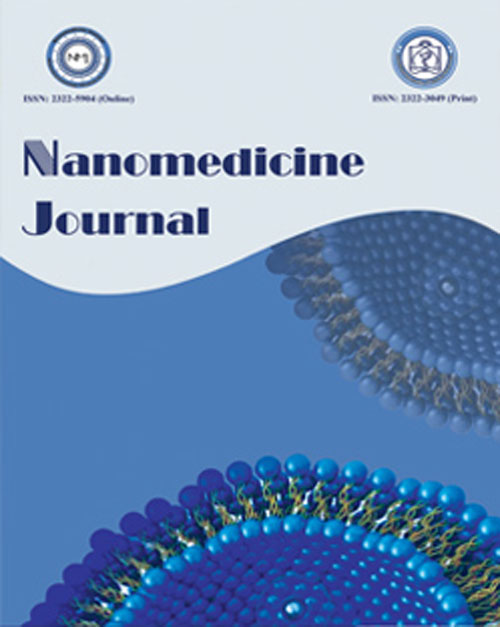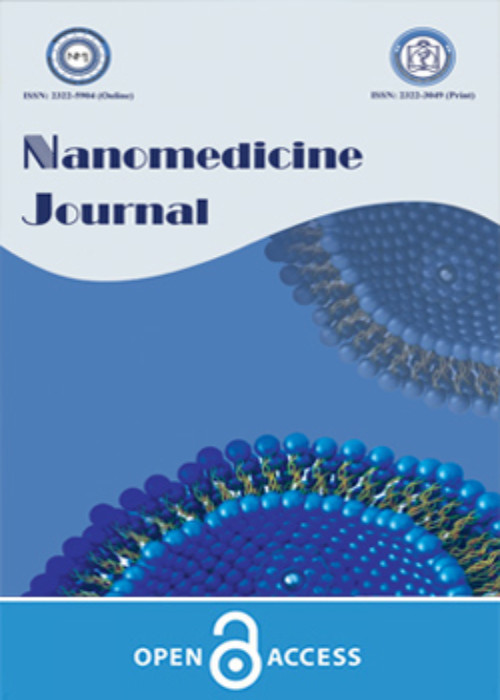فهرست مطالب

Nanomedicine Journal
Volume:5 Issue: 1, Winter 2018
- تاریخ انتشار: 1396/10/10
- تعداد عناوین: 8
-
-
Pages 1-5Recognition of different agents including chemical and biological plays important role in forensic, biomedical and environmentalfield.In recent decades, nanotechnology and nano materials had a high impact on development of sensors. Using nanomaterials in construction of biosensors can effectively improve the Sensitivity and other features of biosensors. Different type of nanostructures including nanotubes, nanodiamonds, thin films ,nanorods, nanoparticles(NP), nanofibers andvarious clusters have been explored and applied in construction of biosensors. Among nanomaterials mentioned above, gold nanoparticle (GNP)as a new class of unique fluorescence quenchers, is receiving significant attention in developing of optical biosensors because of their unique physical, chemical and biological properties. In this mini review, we discussed the use of GNPs in construction of colorimetric aptasensorsas a class of optical sensors for detection of antibiotics, toxins and infection diseases.Keywords: Colorimetric aptasensor, Gold nanoparticles, Toxins, Antibiotics
-
Pages 6-14Objective(s)Chitosan based composite fine fibers were successfully produced via a centrifugal spinning technology. This study evaluates the ability of the composites to function as scaffolds for cell growth while maintaining an antibacterial activity.Materials And MethodsTwo sets of chitosan fiber composites were prepared, one filled with anti-microbial silver nanoparticles and another one with cinnamaldeyhde. Chitosan powder was dissolved in trifluoroacetic acid and dichloromethane followed by addition of the fillers. The fiber output was optimized by configuring the polymer weight concentration (7, 8, and 9 w/w% chitosan) and applied angular velocity (6000-9000 RPM) within the spinning process.ResultsScanning electron microscopy revealed fiber diameters ranging from 800-1500 nm. Cinnamaldehyde and silver nanoparticles helped to improve and control the anti-bacterial activity. Through a verified cell counting method and disk diffusion method, it was proven that the chitosan based composite fibers possess an enhanced anti-bacterial/microbial activity against gram-positive Staphylococcus aureus. Both composite systems showed anti-bacterial activity, inhibition zones fluctuating between 5 to 10 mm were observed depending on the size of the fiber matand no bacteria was found within the mats. The developed fiber scaffolds were found to be noncytotoxic serving as effective three-dimensional substrates for cell adhesion and viability.ConclusionThese results provide potential to use these scaffolds in wound healing and tissue regeneration applications.Keywords: Anti-microbial, Cell adhesion, Chitosan, Cinnamaldehyde, Forcespinning, Silver nanoparticles, Wound dressing
-
Pages 15-18ObjectiveIn this study, the zeolite-coated iron oxide nanoparticles were evaluated as MRI contrast agent and effect of the nanocomposite synthesis method on MRI contrast was tested.Materials And MethodsIon exchange method was used for synthesis of iron oxide-zeolite and the as prepared nanocomposite was characterized by XRD, FESEM and TEM. The nanocomposite toxicity in the cell culture, and then their effect on MRI contrast were investigated.ResultsThe results showed a properly crystallized nanocomposite with the size of 120-180 nm. Iron oxide nanoparticles were capsulated in the pores of the zeolite. A very small amount of the nanoparticles were placed on the composite outer surface that led to enough free space on the zeolite surface. The nanocomposite was not toxic for the cell line and its MRI r2 relaxivity was calculated 127.14 mM-1s-1.ConclusionIron oxide-zeolite nanocomposite synthesized by ion exchange method is introduced as an MRI T2 contrast agent with a great potential for drug loading purposes.Keywords: Contrast, Ion exchange, Iron oxide nanoparticles, MRI, Zeolite
-
Pages 19-26Objective(s)Antibacterial materials are so significant in the textile industry, water disinfection, medicine, and food packaging. Unfortunately, organic compounds for sterilization show toxicity to the human body; therefore, the interest in inorganic disinfectants such as metal oxide nanoparticles (NPs) is increasing.Materials And MethodsNickel and nickel hydroxide nanoparticles (NiNPs and Ni(OH)2-NPs) were prepared and characterized by DLS, SEM, AFM and ATR. Antibacterial activity assay was carried by Spot on lawn method against two selected standard pathogenic bacteria such as E. coli (as Gram negative), S. aureus (as Gram positive) and multidrug resistance K. pneumonia and E. coli. Also the minimum inhibitory concentration (MIC) and minimum bactericidal concentration (MBC) were determined against two selected standard pathogenic bacteria and multidrug resistance K. pneumonia and
E. coli.ResultsThe formation of the NiNPs and Ni(OH)2-NPs were confirmed by DLS, SEM, AFM and ATR. Antibacterial activity of nanoparticles were confirmed against two selected standard pathogenic bacteria such as E. coli and S. aureus. And also, NiNPs and Ni(OH)2-NPs revealed fair antibacterial effect against multidrug resistance K. pneumonia and E. coli based on MIC and MBC data. As well, the experimental data presented that the antibacterial activity of NiNPs was more than Ni(OH)2-NPs.ConclusionBased on the achieved results, NiNPs and Ni(OH)2-NPs show antibacterial activity against clinical patients bacteria (multidrug resistance K. pneumonia and E. coli(. Finally, the NPs evaluated in this study have promising properties for applications as antiseptic agent for environment; however, further studies are warranted such as study toxicity NPs on normal human cell line and other clinical bacteria.Keywords: Antibacteial, NiNPs, Ni(OH)2, Nanoparticles, Pathogen -
Pages 27-35Objective(s)Combination anticancer therapy holds promise for improving the therapeutic efficacy of chemotherapy drugs such as doxorubicin (DOX) as well as decreasing their dose-limiting side effects. Overcoming the side effects of doxorubicin (DOX) is a major challenge to the effective treatment of cancer. Zinc oxide nanoparticles (ZnO NPs) are emerging as potent tools for a wide variety of biomedical applications. The aim of this study was to develop a combinatorial approach for enhancing the anticancer efficacy and cellular uptake of DOX.Materials And MethodsZnO NPs were synthesized by the solvothermal method and were characterized by X-ray diffraction (XRD), dynamic light scattering (DLS) and transmission electron microscopy (TEM). ZnO NPs were dispersed in 10% bovine serum albumin (BSA) and the cytotoxic effect of the resulting ZnO nanofluids was evaluated alone and in combination with DOX on DU145 cells. The influence of ZnO nanofluids on the cellular uptake of DOX and DOX-induced catalase mRNA expression were investigated by fluorescence microscopy and semi-quantitative reverse transcription-polymerase chain reaction (RT-PCR), respectively.ResultsThe MTT results revealed that ZnO nanofluids decreased the cell viability of DU145 cells in a timeand dose-dependent manner. Simultaneous combination treatment of DOX and ZnO nanofluid showed a significant increase in anticancer activity and the cellular uptake of DOX compared to DOX alone. Also, a time-dependent reduction of catalase mRNA expression was observed in the cells treated with ZnO nanofluids and DOX, alone and in combination with each other.ConclusionThese results indicate the role of ZnO nanofluid as a growth-inhibitory agent and a drug delivery system for DOX in DU145 cells. Thus, ZnO nanofluid could be a candidate for combination chemotherapy.Keywords: Anticancer activity, Catalase, Doxorubicin, Prostate cancer, ZnO nanofluids
-
Pages 36-45Objective(s)The interaction of DNA with iron oxide nanoparticles (SPIONs) was studied to find out the interaction mechanism and design new drug delivery systems.Materials And MethodsThe interaction of calf thymus DNA (ctDNA) with SPIONs doped with 2H-chromene via dopamine as cross linker (SPIONs@DA-Chr) was studied using the UV absorption spectroscopy, viscosity measurement, circular dichroism, fluorescence and FT-IR spectroscopic techniques.ResultsUV absorption study showed hyperchromic effect in the spectra of DNA. Few changes were observed in the viscosity of ctDNA in the presence of different concentration of SPIONs@DA-Chr. The result of circular dichroism (CD) suggested that SPIONs@DA-Chr can change the secondary structure of DNA. Further, fluorescence quenching reaction of ctDNA with SPIONs@DA-Chr and competitive fluorescence spectroscopy studied by using methylene blue, have shown that the SPIONs@DA-Chr can bind to ctDNA through non-intercalative mode. FT-IR spectroscopy confirmed the binding of SPIONs@DA-Chr and ctDNA.ConclusionThese results suggested that SPIONs@DA-Chr binds to DNA via groove binding mode.Keywords: DNA interaction, Dopamine, Iron oxide nanoparticles, Spectroscopy
-
Pages 46-51Objective(s)Silver nanostructures have gathered remarkable attention due to their applications in diverse fields. Researchers have recently demonstrated that bacterial spores are capable of reducing silver ions to elemental silver leading to formation of nanoparticles.Materials And MethodsIn this study, spores of Bacillus subtilis and Geobacillus stearothermophilus were employed to produce silver nanoparticles (SNPs) from silver nitrate (AgNO3) through a green synthesis method. The production of SNPs by spores, heat inactivated spores (microcapsule) and spore extracts was monitored and compared at wavelengths between 300 to 700 nm. The biosynthesized SNPs by spore extracts
were characterized and confirmed by XRD and TEM analyses.ResultsUV-Visible spectroscopy showed that the spore extracts were able to synthesize more SNPs than the other forms. The XRD pattern also revealed that the silver nanometals have crystalline structure with various topologies. The TEM micrographs showed polydispersed nanocrystal with dimensions ranging from 30 to 90 nm and 15 to 50 nm produced by spore extracts of B. subtilis and G. stearothermophilus, respectively.
Moreover, these biologically synthesized nanoparticles exhibited antimicrobial activity against different opportunistic pathogens.ConclusionThis study suggests the bacterial spore extract as a safe, efficient, cost effective and eco-friendly material for biosynthesis of SNPs.Keywords: Bacillus subtilis, Geobacillus stearothermophilus, Silver nanoparticles, Spore extract -
Pages 52-56Objective(s)Nanotechnology has enabled researchers to synthesize nanosize particles that possess increased surface areas. Compared to conventional microparticles, it has resulted in increased interactions with biological targets.The objective of this study was to determine the protective ability of selenium nanoparticles compared to selenium against parasetamol hepatotoxicity and GPX concentration.Materials And MethodsSeventy-two male rats were used in the study, and arbitrarily assigned to six groups. There were 12 rats in each group that six rat were tested in each period. Blood samples were collected from rats for measuring liver enzymes and GPX activity.ResultsThe present study shows that parasetamol has a toxic effect on the liver as a result of inducing a marked oxidative damage and release of reactive oxygen species. This was shown by the significant increases in ALP, AST, ALT and LDH activity which was accompanied by significant decrease in GPX activity in the parasetamol -treated group compared to the control, selenium and selenium nanoparticles groups. There was no significant difference between selenium and selenium nanoparticles groups and two period time (15 and 30 day).Conclusionselenium nanoparticles and selenium have protective against paracetamol.Keywords: GPX activity, Hepatotoxicity, Parasetamol, Selenium nanoparticles


